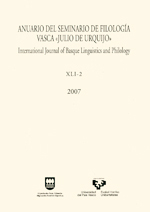Consequences of pair-merge (at the interfaces)
##plugins.themes.bootstrap3.article.main##
##plugins.themes.bootstrap3.article.sidebar##
Publicado
13-04-2007
Aritz Irurtzun
Ángel J. Gallego
Resumen
The goal of this paper is to explore the basic properties of adjuncts and some of the well-known puzzles these dependents pose for syntactic theorizing within the scenario provided by the Minimalist Program (cf. Chomsky 1995 through the present). In so doing, we will briefly discuss some controversial issues, like the argument-adjunct distinction, the status of the (still poorly understood, and worse formally classified) notion of 'deviance', and the semantic contribution of adjuncts, but the main focus of this paper will be the formal operation of pair-Merge, put forward by Chomsky (2000) and assumed to handle adjunction within the current framework. In league with Uriagereka (2003), we want to argue that adjuncts can give rise to two different readings, which we will call Markovian and non-Markovian. The first one is quite common in the literature, and plausibly instantiates the Davidsonian analysis, whereby adjuncts are mechanically concatenated predicates of the event.
Cómo citar
Irurtzun, Aritz, y Ángel J. Gallego. 2007. «Consequences of Pair-Merge (at the Interfaces)». Anuario Del Seminario De Filología Vasca "Julio De Urquijo" 41 (2):179-200. https://doi.org/10.1387/asju.3896.
##plugins.themes.bootstrap3.article.details##
Sección
Artículos
Esta obra está bajo una licencia Creative Commons Atribución-NoComercial-SinDerivadas 4.0 Internacional.


